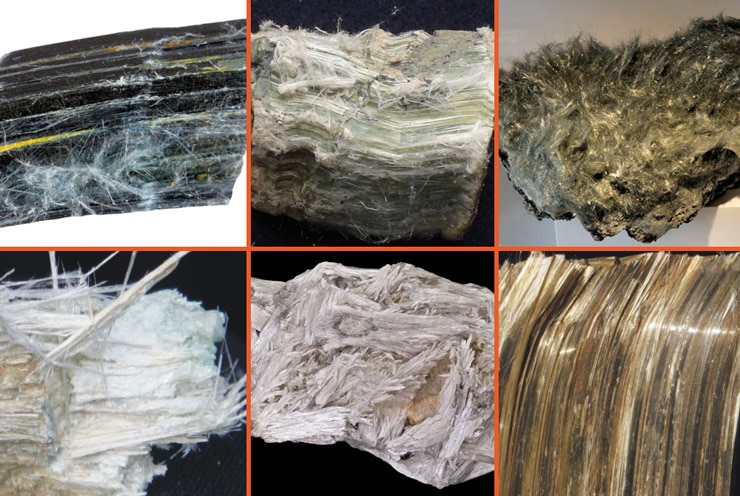Types of Asbestos
Whether you’re concerned for your home or business, there’s no denying the risks associated with hidden asbestos. What’s more, there are different types of asbestos out there, each of which are toxic and very dangerous to breathe in or be near.
Our goal is to provide you with sound, reliable information, and we’re happy to assist with dedicated asbestos testing services on ceilings and tiles in addition to air quality testing for asbestos that utilizes the resources of accredited lab partners.
6 Types of Asbestos Materials

- Chrysotile asbestos. More commonly referred to as “white asbestos”, chrysotile is a variant mined in Quebec and Vermont that was primarily used in roofing, ceilings, insulation, and flooring. It’s one of the most commonly found types of asbestos, found in 95 percent of buildings. This is largely due to the banning of asbestos not taking place in Canada until 2018, so even recent constructions may contain it. There is no form of asbestos that is safe for humans, but chrysotile is not the most lethal when it comes to raw exposure. That being said, don’t leave it in your home or business any longer than you have to.
- Amosite asbestos. Most people call this “brown asbestos” due to its appearance resembling a rich, dark wood in terms of colour. Amosite doesn’t absorb in water very well, and it’s only found in five percent of buildings at this point. With that said, you can still find it in everything from insulation to tiling, roofing materials, and cement sheets.
- Crocidolite asbestos. Easily the most lethal and dangerous type of asbestos, crocidolite’s pretty blue hue is anything but a fluffy delight. It also doesn’t absorb into water very easily and, while not widely used, is common enough in everything from cement products and tiles to insulation. Any form of direct exposure to this material is extremely toxic and, should this happen, you need to seek out medical attention as soon as possible as a precaution.
- Anthophyllite asbestos. Anthophyllite consists of very tightly packed mineral-based fibres, much like some other forms of asbestos. It was manufactured up until the mid-1970s, so it’s more common in homes that have been handed down through a few generations or so. Common use cases include insulation like other variants in addition to roofing materials. Breathing in or touching the material can be highly toxic, especially to those with pre-existing lung issues.
- Tremolite asbestos. Tremolite is more commonly found in specialized vermiculite insulation materials, various older paints, sealants, talc, and roofing materials. It’s been around since at least the late 1780s, making it one of the oldest and longest-used variants of asbestos. Like other variants, it can cause everything from lung cancers to forms of mesothelioma, so tread lightly around it and be sure to call in professionals for accurate testing.
- Actinolite asbestos. Actinolite used to be popular for use in gardening materials, various forms of fireproofing, and insulation products. Some forms of the mineral have been used as gemstones in the past given that actinolite is usually found in metamorphic rocks or limestone concentrations. Fibres are very small and can easily penetrate the lungs, much like most other forms of asbestos, making it very dangerous to breathe in.
Need Your Air or Property Tested for Asbestos?
Frequently Asked Questions
How many types of asbestos are there?
The six types of asbestos we’ve mentioned above are the ones you may find within your home or business, especially if the property is much older. If you haven’t had a test done to confirm the presence of any of these variants, we recommend doing so as soon as possible to protect yourself.
Which is the most dangerous type of asbestos?
Crocidolite is by far the most lethal and hazardous form of insulation. Never touch or go near it. In fact, the same applies to all forms of asbestos – each has a high likelihood of making building occupants very sick, but some can cause serious harm or even worse from direct exposure such as touching or breathing in fibres.
What should I do if I suspect asbestos is present in my home?
Reach out to us straight away. We’ll be happy to work out a fair and appropriate quote for an air quality and property test, ensuring you know for certain just what is present in your home. We send air samples to only accredited laboratories that have experience with all types of asbestos, ensuring clearer and more accurate findings.

Get Special Gift: Industry-Standard Mold Removal Guidelines
Download the industry-standard guidelines that Mold Busters use in their own mold removal services, including news, tips and special offers:
"*" indicates required fields
Published: May 2, 2023 Updated: June 6, 2023

Written by:
John Ward
Account Executive
Mold Busters
Fact checked by:
Michael Golubev
CEO
Mold Busters
